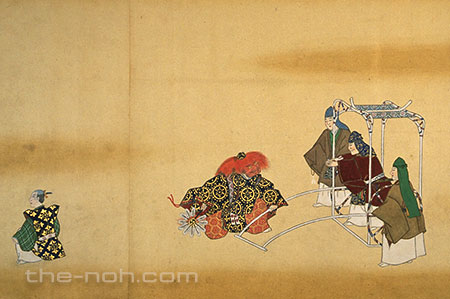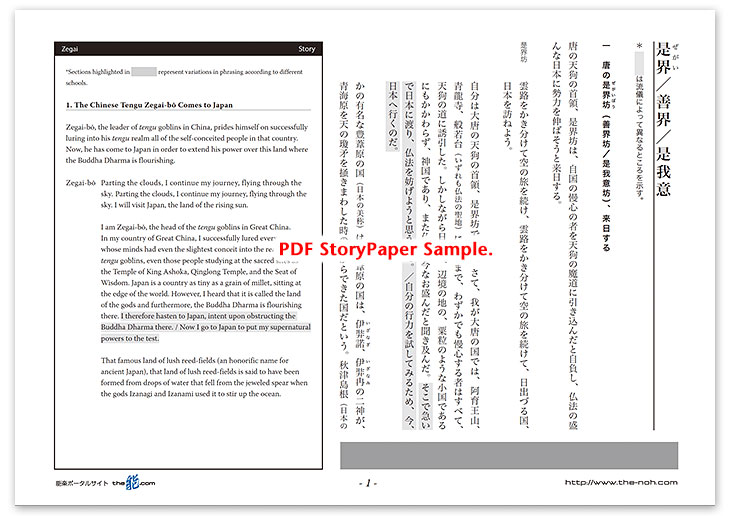
 Zegai
Zegai

![]()
Zegai-bō, a tengu (flying goblin), is proud that he has successfully lured all of the self-conceited people in China into his tengu realm. Intending to pull more people into his realm, he comes to Japan. He visits Tarō-bō, the tengu inhabiting Mount Atago, and tells Tarō-bō about his plan to obstruct the Buddha Dharma in Japan, the land of the gods, where Buddhism is flourishing. Tarō-bō agrees to this plan to expand their realm in Japan and recommends that Zegai-bō attack the temple complex on Mount Hiei. Zegai-bō is hesitant to attack Mount Hiei, where the Buddha Dharma is particularly well developed through the study of both exoteric and esoteric Buddhist teachings, admitting that he is especially afraid of the deity Acalanathanatha, the immovable defender who fiercely guards the temple. However, because Tarō-bō keeps pushing him and offers to be his guide to the mountain, the emboldened Zegai-bō departs for Mount Hiei, flying on a cloud together with Tarō-bō.
At Mount Hiei, the abbot of Imuro is about to depart for Kyoto because he received an imperial order to come and offer prayers as the city is experiencing abnormal events that seem to be caused by tengu. Therefore, a messenger from the temple starts out for Kyoto ahead of the abbot with a list of sutras*, but strong gusts of wind fiercely blow towards him. He is afraid that it must be a tengu who is making these gusts and returns to the temple complex of Mount Hiei.
As the abbot of Imuro descends Mount Hiei on his way toward Kyoto, a thunder storm hits him. It is indeed Zegai-bō who causes the storm as he tries to prevent the abbot from going to Kyoto. Although the abbot hears, coming from the storm clouds, voices chanting heretical verses, he calmly prays to Acalanatha. When he does so, Acalanatha appears, bringing with him other deities who are protectors of the Buddha Dharma and they together exercises their powers of subjugating demons. Furthermore, even the Shinto gods arrive and blow forth such powerful winds that Zegai-bō is unable to fly and falls to the ground, exhausted. Zegai-bō hides himself and runs away into the clouds, leaving behind a message that he will never come back.
*List of sutras: A catalog that records the titles, the number of volumes, and counts of recitation of sutras or dharani incantations recited by monks when offering prayers or conducting a memorial service.
![]()
This play lauds the greatness of the Buddha Dharma with its story that even a tengu, a dominant figure in the realm of devils, is no match for its awesome power. The highlight of this drama is the fight between Zegai-bō and waki (the abbot) in the second half. This play seems to be a simple story about vice being punished. However, if you understand the historical background and peculiar characteristics of tengu, the goblins of Japanese folklore, this drama becomes even more mysterious and interesting, and you will surely enjoy it more. We will therefore provide some information about tengu.
Today, tengu is typically depicted in the form of a man with a long nose and red face, wearing the attire of a Shugendo mountain ascetic (yamabushi), holding a unique fan, wearing a pair of tall wooden clogs, and flying with wings. However, in ancient Japan, tengu meant a shooting star (meteor). Tengu did not appear for many years in Japanese history, but toward the end of the Heian period (late 8th century to early 12th century), they suddenly started cropping up in folklore and historical documents. By the end of the Heian period, tengu had ceased being a meteor and had been transformed into a half-man, half-bird with the ability to fly. Also by this time, tengu had incorporated the characteristics of yamabushi mountain ascetics. This development can probably be attributed to the image of these ascetics, who run across the mountains and possess supernatural powers, being well suited to the image of tengu, a flying goblin living in the lower realms. Thus the visual image of tengu was fixed as donning the attire of mountain ascetics and they always appears in that costume in Noh dramas such as Kurama Tengu and Kuruma-sō.
While people hold tengu in awe because of their extraordinary supernatural powers, tengu are also known for their extreme self-conceit. That arrogance is on display when in this play, Zegai, when Zegai-bō proudly boasts that he has lured many self-conceited people into his dark realm.
STORY PAPER : Zegai
Story Paper presents noh chant stories in modern speech, with story outlines, highlights and more using Adobe PDF format, which can print out and zoom in. Print out the pages and take them with you when you see the actual noh performance.

The copyright of Story Paper is held by the Noh.com. Story Paper is for individual use only. It is prohibited by the copyright law to distribute or publish printed-out Story Paper pages without prior consent. For more information, check the credit and disclaimer pages.



 [Zegai : Story Paper PDF : 618KB
[Zegai : Story Paper PDF : 618KB